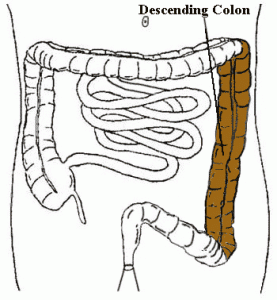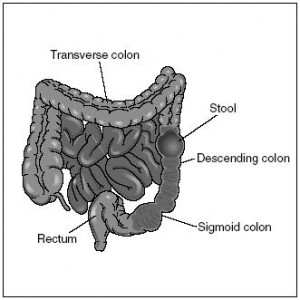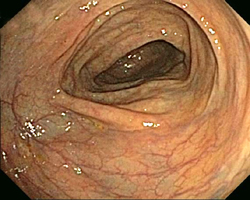What is Descending colon?
It is a section of the large intestine. It is a part of the colon that passes down through the left hypochondrium. It also passes through the lumbar areas and along the side of the left kidney ultimately connecting with the sigmoid colon.
Descending colon Location
The organ is surrounded by other vital organs, such as the small intestine and the left kidney. As its name suggests, the descending colon slopes downwards; straight to the side of the left kidney as well as the left section of the abdominal wall. Certain coils of the small intestine are located in front of the organ.
Picture 1 – Descending colon
Descending colon Description
Tubular in shape, the descending colon is comprised of strong muscles surrounded by the peritoneum which help it perform its main functions in the overall work of the colon. The anterior surface and the sides of the organ are covered by the peritoneum, which is the reason why the descending colon is known as retroperitoneal. In contrast, the sigmoid colon and transverse colon are intraperitoneal.
The areolar tissue joins the posterior surface of the descending colon with
- The lateral and lower part of the left kidney
- The aponeurotic root of the transversus abdominis
- The quadratus lumborum
The descending colon is smaller in quality and positioned more deeply than the ascending colon. The organ is covered with peritoneum more frequently on its posterior surface than the ascending colon. However, it is less probable to go through volvulus as compared to the ascending colon.
Descending colon Functions
It primarily serves to absorb water from fecal matter. It also stores food particles that are to be emptied into the rectum. While working in a downward movement, this organ continues to push the digested waste products. The wastes move downwards from the transverse colon to the sigmoid colon. They ultimately enter the rectum to be expelled during excretion. While moving the waste material, the descending colon also continues to take out any remaining nutrients and water from them.
Descending colon Disorders
The descending colon is a more vulnerable section of the colon. It is associated with several disorders, which include:
Crohn’s disease
It is a severe, progressive inflammation of the section of the small intestine (ileum) between the cecum and the jejunum. The condition is chronic in nature. It gives rise to frequent episodes of diarrhea along with other discomforting symptoms like nausea, fever, weight loss and abdominal pain.
Ulcerative colitis
Also known as inflammatory bowel disease, it is a chronic inflammatory disease of an acute nature. It mainly affects the large intestine and rectum. The condition is marked by recurring episodes of
- Abdominal pain
- Bleeding
- Chills
- Fever
- Profuse diarrhea
- Loss of appetite
- Loss of weight
- Presence of high mucus content in fecal matter
The disease initially manifests itself with symptoms like abdominal swelling and development of ulcers on the lining of the bowel. It can affect any section of the colon. It is known as left-sided colitis when it impacts the descending colon.
Colon cancer
Cancer of the descending colon is the most severe of all the disorders affecting it. An individual may suffer from colon cancer without displaying any symptoms in the initial stages. Naturally, regular colorectal tests are required to diagnose the disease in its first stages. However, colon cancer may be suspected by several early signs like:
- Sudden changes in bowel habits
- Rectal bleeding
- Dark stools
- Frequent constipation
- Presence of mucus in the stools
Treatment options can depend on the complete state of health of the patient as well as the stage of cancer.
Problems in this colon may also occur due to a simple bacterial infection. If an infection is the case, antibiotics can help clear it up. If you are suffering from any of the descending colon symptoms over a long period of time, you should visit a healthcare professional for immediate diagnosis and treatment. A delay in treatment can often cause serious problems in future.
How to Maintain Descending colon?
Keeping the descending colon clean can ensure good health. If the organ is affected in some way, serious complications can occur which can be dangerous for health. When the colon becomes impacted, it prevents the passing of waste products past the point of impaction through the colon.
Problems in the descending colon causes usually arise as a direct consequence of faulty dietary habits. Individuals who eat a high amount of fatty fast foods are more susceptible to colon impactions than people following a high-fiber diet. High intake of refined foods can also lead to problems in the organ due to the amount of processing they go through. Most processed foods contain a high amount of sodium and preservatives that do not have any benefits for the body.
Problems in the descending colon can be avoided by drinking plenty of water and eating foods that are rich in fiber content. This helps a lot in cleaning the system. Drinking at least six to eight glasses of water every day can help you clean your colon and also stay hydrated. However, it is also necessary to cleanse the organ. Using colonics or some other product for colon cleansing can be a way to prevent impaction. As per medical studies, cleansing for about four times a year can make a person feel better and have reduced chances of suffering from ailments.
You may also ensure good health of the organ by:
- Cutting down or avoiding smoking
- Putting a limit on alcohol intake
- Regular exercise
Following a healthy lifestyle can help you preventing descending colon problems as well as other general ailments. A healthy colon can help you become mentally more alert, function with more energy and have fewer weight gain issues.
Descending colon Pictures
Here are some useful Descending colon photos that help show a pictorial impression of the organ. Check these Descending colon images to know about the appearance of the structure.
Picture 2 – Descending colon Image
Picture 3 – Descending colon Photo
References:
http://www.coloncleanseaid.com/colon-anatomy/descending-colon/
http://www.coloncleansehaven.com/descending-colon.html
http://www.wisegeek.com/what-is-a-descending-colon.htm




No comments yet.